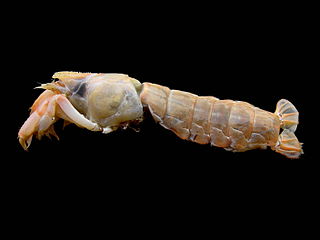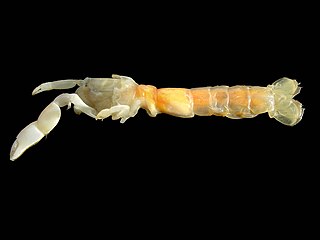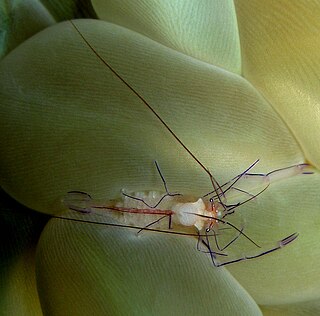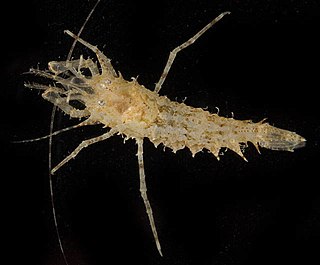
Dendrobranchiata is a suborder of decapods, commonly known as prawns. There are 540 extant species in seven families, and a fossil record extending back to the Devonian. They differ from related animals, such as Caridea and Stenopodidea, by the branching form of the gills and by the fact that they do not brood their eggs, but release them directly into the water. They may reach a length of over 330 millimetres (13 in) and a mass of 450 grams (1.0 lb), and are widely fished and farmed for human consumption.

Krill(Euphausiids) are small and exclusively marine crustaceans of the order Euphausiacea, found in all the world's oceans. The name "krill" comes from the Norwegian word krill, meaning "small fry of fish", which is also often attributed to species of fish.

Thalassinidea is a former infraorder of decapod crustaceans that live in burrows in muddy bottoms of the world's oceans. In Australian English, the littoral thalassinidean Trypaea australiensis is referred to as the yabby, frequently used as bait for estuarine fishing; elsewhere, however, they are poorly known, and as such have few vernacular names, "mud lobster" and "ghost shrimp" counting among them. The burrows made by thalassinideans are frequently preserved, and the fossil record of thalassinideans reaches back to the late Jurassic.

Axiidea is an infraorder of decapod crustaceans. They are colloquially known as mud shrimp, ghost shrimp, or burrowing shrimp; however, these decapods are only distantly related to true shrimp. Axiidea and Gebiidea are divergent infraoders of the former infraorder Thalassinidea. These infraorders have converged ecologically and morphologically as burrowing forms. Based on molecular evidence as of 2009, it is now widely believed that these two infraorders represent two distinct lineages separate from one another. Since this is a recent change, much of the literature and research surrounding these infraorders still refers to the Axiidea and Gebiidea in combination as "thalassinidean" for the sake of clarity and reference. This division based on molecular evidence is consistent with the groupings proposed by Robert Gurney in 1938 based on larval developmental stages.

The Australian ghost shrimp, marine yabby, or ghost nipper is a species of ghost shrimp in the family Callianassidae, found in Australia and the Indo-West Pacific region.

Betaeus is a genus of shrimp in the family Alpheidae, containing the following species:

Metanephrops is a genus of lobsters, commonly known as scampi. Important species for fishery include Metanephrops australiensis and Metanephrops challengeri. It differs from other lobsters such as Homarus and Nephrops norvegicus in that its two main claws are of equal size, rather than being differentiated into a crusher and a pincher. There are 18 extant species recognised in the genus:

Callianassidae is a family of ghost shrimp crustaceans belonging to the infraorder Axiidea, within the order Decapoda.
Callianassa is a genus of mud shrimps, in the family Callianassidae. Three of the species in this genus have been split off into a new genus, Pestarella, while others such as Callianassa filholi have been moved to Biffarius. The genus is named after the Nereid of the Greco-Roman mythology.

Hippolyte is a genus of shrimp in the family Hippolytidae, containing the following species:

Palaemonidae is a family of shrimp in the order Decapoda. Many species are carnivores that eat small invertebrates, and can be found in any aquatic habitat except the deep sea. One significant genus is Macrobrachium, which contains commercially fished species. Others inhabit coral reefs, where they associate with certain invertebrates, such as sponges, cnidarians, mollusks, and echinoderms, as cleaner shrimps, parasites, or commensals. They generally feed on detritus, though some are carnivores and hunt tiny animals.

Thalassina is a genus of mud lobsters found in the mangrove swamps of the Indian Ocean and western Pacific Ocean. Its nocturnal burrowing is important for the recycling of nutrients in the mangrove ecosystem, although it is sometimes considered a pest of fish and prawn farms.

Neotrypaea californiensis, the Bay ghost shrimp, is a species of ghost shrimp that lives on the Pacific coast of North America. It is a pale animal which grows to a length of 11.5 cm (4.5 in). One claw is bigger than the other, especially in males, and the enlarged claw is thought to have a function in mating. N. californiensis is a deposit feeder that lives in extensive burrow systems, and is responsible for high rates of bioturbation. It adversely affects oyster farms, and its numbers are controlled in some places by the application of pesticides. It carries out an important role in the ecosystem, and is used by fishermen as bait.

Neotrypaea is a genus of ghost shrimp in the family Callianassidae, containing the following sixteen species:

Pilodius is a genus of crabs in the family Xanthidae, containing the following species:

Medaeus is a genus of crabs in the family Xanthidae, containing the following species:

A shrimp (pl.: shrimp or shrimps is a crustacean with an elongated body and a primarily swimming mode of locomotion – typically belonging to the Caridea or Dendrobranchiata of the order Decapoda, although some crustaceans outside of this order are also referred to as "shrimp".

Vir is a genus of shrimp comprising the following species:

Hemisquilla australiensis is a species of mantis shrimp native to Australia and also found in New Zealand.

Paracrangon is a genus of deep-sea shrimp in the family Crangonidae, found on the Pacific coasts of North America, Asia, and Australia. Morphologically, they are notable for several autapomorphies, most significantly their unique lack of second pereopods, but also for their partially flexible abdomen, which allows them to assume their defensive cataleptic posture. Species also have long spines covering their carapace. They are distinctive among the Crangonid shrimp, and are almost certainly monophyletic. All species except Paracrangon echinata, the type species, are quite rare.


















